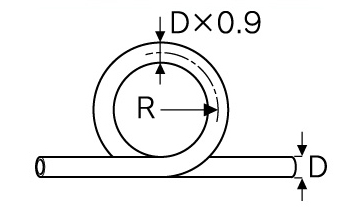Hose and Coupling Knowledge Base
If You Register to Become a Web Member, We Will Send You the Latest Information on Hoses and Coupling.
How to Read Catalog Specifications, Part 3 – Minimum Bend Radius

We want our hoses to be flexible and curve. Although plastic hoses have the advantage of being flexible, making the layout easy, in tight places hoses can bend into angles that do not allow the content to pass through.
With metal pipes, the bend angle is set first, and even with a small bend radius, the pipe can be worked to maintain a round surface. Although plastic hoses may be round when straight, when bent, they warp so the cross-section may be oval. If the hose is bent too much, nothing can pass through. The minimum bend radius is the smallest radius at which the content can still pass through the hose smoothly. At Toyox, the minimum bend radius is considered the radius of the curve in the hose with the outer diameter at 90% of its normal size at room temperature.
The minimum bend radius may vary greatly depending on the conditions of the use environment, especially temperature. Also, hoses bend more easily at higher temperatures, so we recommend making the bend radius as large as possible to prevent disconnects, bursts and other secondary problems that can be caused by hose bending.
Metal or other coil reinforced hoses are recommended over braid reinforced hoses for bending and collapsing strength. The differences in “shape retaining characteristics” can be seen in the video.
Archive
How to Cut Steel-Wire-Reinforced PVC Hose
Does Electricity Conservation Increase Condensation?
Why Do Hoses Leak & Disconnect?
Can PVC & Other Plastic Hoses Be Used for Fuel Gas & Kerosene?
How to Read Catalog Specifications, Part 4 – Are Hose Sizes Random?
How to Read Catalog Specifications, Part 3 – Minimum Bend Radius
Beware of Static Electricity on Hoses
How to Read Catalog Specifications, Part 2 – Negative Pressure+B10
About REACH, RoHS, Endocrine Disruptor & the Food Sanitation Act
How to Read Catalog Specifications, Part 1 – Use Pressure
How to Avoid Damage Caused by Ultraviolet Rays
The Dangers of Hose Condensation
Why Transparent Hoses Become Cloudy
Leaks & Disconnections Due to Mismatched Couplings & Hoses
Causes & Solutions for Leaks & Disconnections
The Benefits of the Right Hose for the Situation (2)









